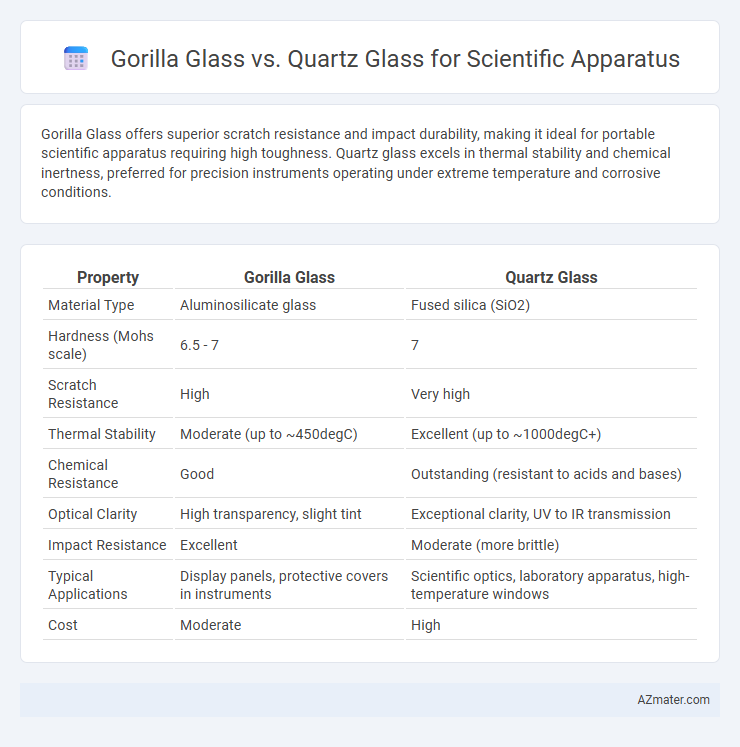Gorilla Glass offers superior scratch resistance and impact durability, making it ideal for portable scientific apparatus requiring high toughness. Quartz glass excels in thermal stability and chemical inertness, preferred for precision instruments operating under extreme temperature and corrosive conditions.
Table of Comparison
| Property | Gorilla Glass | Quartz Glass |
|---|---|---|
| Material Type | Aluminosilicate glass | Fused silica (SiO2) |
| Hardness (Mohs scale) | 6.5 - 7 | 7 |
| Scratch Resistance | High | Very high |
| Thermal Stability | Moderate (up to ~450degC) | Excellent (up to ~1000degC+) |
| Chemical Resistance | Good | Outstanding (resistant to acids and bases) |
| Optical Clarity | High transparency, slight tint | Exceptional clarity, UV to IR transmission |
| Impact Resistance | Excellent | Moderate (more brittle) |
| Typical Applications | Display panels, protective covers in instruments | Scientific optics, laboratory apparatus, high-temperature windows |
| Cost | Moderate | High |
Introduction to Glass Types in Scientific Apparatus
Gorilla Glass, a chemically strengthened aluminosilicate glass, offers exceptional scratch resistance and durability, making it ideal for scientific apparatus exposed to harsh environments. Quartz glass, composed of pure silicon dioxide, provides superior thermal stability and optical clarity, essential for high-precision instruments requiring resistance to thermal shock and chemical corrosion. Selecting between Gorilla Glass and Quartz Glass depends on the specific application requirements, such as mechanical strength versus thermal and chemical resilience.
Composition and Structure: Gorilla Glass vs Quartz Glass
Gorilla Glass is composed primarily of alkali-aluminosilicate with a chemically strengthened structure achieved through ion exchange, enhancing its scratch resistance and durability. Quartz glass consists mainly of high-purity silicon dioxide (SiO2) arranged in a crystalline or fused amorphous structure, offering excellent thermal stability and chemical inertness. The ion-exchanged, layered network of Gorilla Glass provides mechanical strength ideal for impact resistance, while Quartz glass's homogeneous, non-crystalline lattice ensures superior optical clarity and resistance to high temperatures in scientific apparatus.
Mechanical Strength and Durability Comparison
Gorilla Glass offers superior mechanical strength due to its chemically strengthened aluminosilicate composition, making it highly resistant to scratching and impact damage compared to quartz glass. Quartz glass excels in thermal stability and chemical inertness but is more brittle, resulting in lower impact resistance and a higher likelihood of fracture under mechanical stress. For scientific apparatus requiring robustness and frequent handling, Gorilla Glass provides enhanced durability, while quartz glass is preferred in high-temperature or chemically reactive environments.
Thermal Resistance and Operating Temperature Range
Gorilla Glass offers excellent thermal resistance with an operating temperature range typically between -20degC and 400degC, making it suitable for scientific apparatus exposed to moderate thermal stress. Quartz glass outperforms Gorilla Glass in thermal resistance, withstanding extreme temperatures up to 1100degC and exhibiting minimal thermal expansion, which is critical for high-precision scientific instruments requiring stable optical and structural properties under intense heat. The choice between Gorilla Glass and Quartz Glass depends on the specific thermal demands of the application, with Quartz Glass favored for high-temperature environments due to its superior thermal stability and resistance to thermal shock.
Chemical Resistance and Reactivity
Gorilla Glass offers moderate chemical resistance but can be susceptible to alkaline solutions, limiting its use in certain scientific applications. Quartz glass exhibits superior chemical resistance, remaining inert against most acids, bases, and solvents, making it ideal for highly reactive environments. Its low reactivity and thermal stability ensure reliable performance in precise scientific apparatus where chemical durability is critical.
Optical Clarity and Light Transmission
Gorilla Glass offers superior optical clarity and high light transmission, making it ideal for scientific apparatus requiring precise visual observation and minimal light distortion. Quartz glass surpasses Gorilla Glass in UV light transmission and resistance to thermal shock, providing exceptional transparency across a broader light spectrum crucial for specialized optical experiments. The choice between Gorilla Glass and Quartz glass depends on the specific spectral requirements and durability needed in scientific applications.
Cost and Availability for Laboratory Use
Gorilla Glass offers a cost-effective and widely available option for scientific apparatus, making it suitable for large-scale laboratory use due to its durability and resistance to scratches. Quartz glass, while more expensive and less readily available, provides superior thermal and chemical resistance essential for high-precision experiments, justifying its higher cost for specialized applications. Laboratories balance these factors by selecting Gorilla Glass for routine equipment and Quartz glass for advanced scientific instruments requiring exceptional performance.
Applications in Scientific Equipment
Gorilla Glass offers enhanced scratch resistance and durability, making it ideal for touchscreen interfaces and protective covers on scientific instruments such as microscopes and spectrometers. Quartz glass exhibits superior thermal stability and chemical inertness, which is essential for laboratory apparatus including reaction vessels, cuvettes, and optical components exposed to high temperatures and corrosive environments. The choice between Gorilla Glass and Quartz glass depends on the specific scientific application's requirements for mechanical strength, thermal resistance, and chemical durability.
Maintenance, Cleaning, and Longevity
Gorilla Glass offers enhanced scratch resistance and durability, making it easier to maintain and clean without frequent replacements in scientific apparatus. Quartz glass provides superior thermal stability and chemical resistance, ideal for environments with high heat or corrosive substances, ensuring long-term performance with minimal degradation. The longevity of quartz glass often surpasses Gorilla Glass in extreme laboratory conditions, though Gorilla Glass excels in impact resistance and ease of upkeep.
Choosing the Right Glass for Your Scientific Needs
Gorilla Glass offers exceptional scratch resistance and durability, making it ideal for scientific apparatus requiring robust, impact-resistant surfaces. Quartz glass provides superior thermal stability and chemical resistance, essential for high-temperature experiments and aggressive chemical environments. Choosing the right glass depends on whether mechanical strength or thermal and chemical performance is the priority for your specific scientific application.

Infographic: Gorilla glass vs Quartz glass for Scientific apparatus
 azmater.com
azmater.com